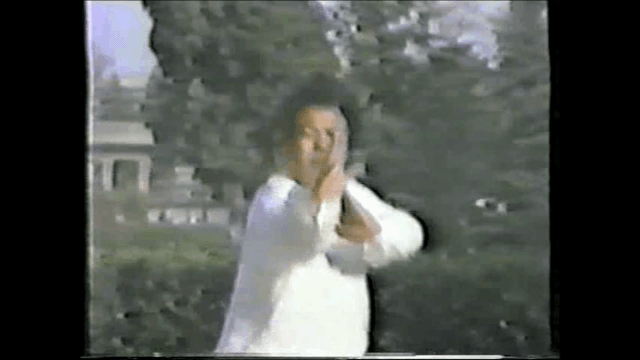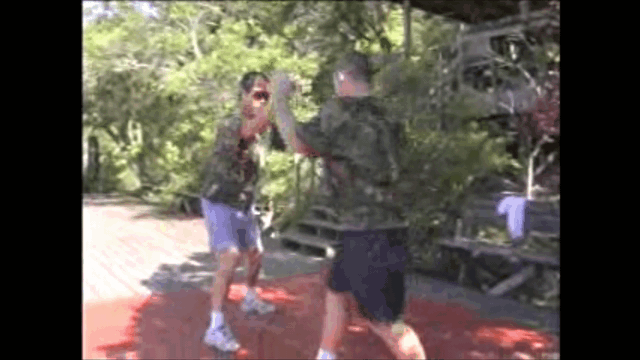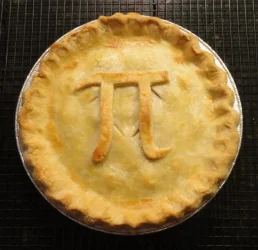Navigation
Install the app
How to install the app on iOS
Follow along with the video below to see how to install our site as a web app on your home screen.
Note: This feature may not be available in some browsers.
More options
Style variation
You are using an out of date browser. It may not display this or other websites correctly.
You should upgrade or use an alternative browser.
You should upgrade or use an alternative browser.
How to deal with circular punches?
- Thread starter Kung Fu Wang
- Start date
dvcochran
Grandmaster
From a defensive boxer or MT perspective circular punches are easier to block or slow down enough to be ineffective by keeping hands/arms up, head down, and using the forearms. I imagine the MT guys try using the elbows as well. A slight twist of the torso or outward movement of the forearm will stop a circular punch. Think of a circular punch coming from downtown like a classic haymaker; you see them from range and they take a lot to develop. I compare them to the 2nd punch in the first video. This should be an each punch to block/redirect if used as a solo tactic.
I like thinking about punches from a geometrical perspective. Linear punches and angular punches. So if we include uppercuts, hooks, and digs into the circular punch category then I think delivery based on range has to be considered. And I consider two rotational axis, vertical (body) & horizontal (arm) each on their respective plane.
Staying with boxing and MMA, you often see the big hook or cross being thrown either as a stepping punch or when coming out of a clinch. The defensive mechanics for both punches are mostly the same but the first punch (stepping) usually has more power behind it however because of the body movement. But also more time is allowed for a defense or counter.
For me, circular punches can/need to be more strategic than a straight punch because they usually open you up more and exhaust more energy. As for blocking them I feel they are easier than a straight punch because there is much more area (fist And forearm) to block compared to a straight punch. Even a glancing block can kill the effects of a circular punch. Glance some straight punches and even though you may not get knocked out you can still be hit in the face.
There are some pretty cool studies on punches. If a circular punch gets to follow through with full strength, velocity, & motion they are stronger than straight punches. But the power is not developed nearly as quick as a straight punch and doesn't increase greatly until much later in the motion. Another reason they are easier to deflect or make ineffective.
Naturally, it is more effective to block a circular punch on the inside of the arm vs. the outside. Strategy comes into play here. You will see out fighters block to the outside part of the arm more often I think.
I like thinking about punches from a geometrical perspective. Linear punches and angular punches. So if we include uppercuts, hooks, and digs into the circular punch category then I think delivery based on range has to be considered. And I consider two rotational axis, vertical (body) & horizontal (arm) each on their respective plane.
Staying with boxing and MMA, you often see the big hook or cross being thrown either as a stepping punch or when coming out of a clinch. The defensive mechanics for both punches are mostly the same but the first punch (stepping) usually has more power behind it however because of the body movement. But also more time is allowed for a defense or counter.
For me, circular punches can/need to be more strategic than a straight punch because they usually open you up more and exhaust more energy. As for blocking them I feel they are easier than a straight punch because there is much more area (fist And forearm) to block compared to a straight punch. Even a glancing block can kill the effects of a circular punch. Glance some straight punches and even though you may not get knocked out you can still be hit in the face.
There are some pretty cool studies on punches. If a circular punch gets to follow through with full strength, velocity, & motion they are stronger than straight punches. But the power is not developed nearly as quick as a straight punch and doesn't increase greatly until much later in the motion. Another reason they are easier to deflect or make ineffective.
Naturally, it is more effective to block a circular punch on the inside of the arm vs. the outside. Strategy comes into play here. You will see out fighters block to the outside part of the arm more often I think.
Flying Crane
Sr. Grandmaster
What flavor is pi pie?View attachment 23087
Have a slice!
What flavor is pi pie?
Well, I'm not entirely sure, this is my opinion, but since Sir Isaac Newton’s favorite dessert was probably apple pie, I'm going with that.
Like I said, it's an opinion, but...an opinion without pi is just an onion, so....I dunno'.
The circular punch is harder to deal with is becauseFrom a defensive boxer or MT perspective circular punches are easier to block ...
- straight punch covers a line. Similar to front/side kick. All you need is to move your body out of that attacking line.
- circular punch covers a space. Similar to roundhouse kick. A powerful circular punch can knock through your guard and still hit your head (similar to a powerful roundhouse kick can break your arm).
This remind me a Kung Fu tournament in Hong Kong. A CLF guy used a right hay-maker on a WC guy. The WC guy used left Tan Shou to block it. Before that day, Ip Men taugh all his students to use
- left Tan Shou to block opponent's right hook (or hat-maker).
- right Tan Shou to block opponent's left hook (or hat-maker).
This rule is seriously applied on Bong Shou (otherwise a wrong Bong can occur).
The CLF guy's hay-maker knocked through the WC guy's Tan Shou and still knocked on the WC guy's head. After that tournament, the WC guy went back to Ip men. Ip Men told him starting from that day, any opponent's right circular punch should be to use the right Tang Shou to block it (by adding a body rotation into it).
3 of Ip Men's students all told me the same story. I believe the above story is true.
Last edited:
Ip Men's modification solved one problem, use body rotation and opposite arm to block a powerful circular punch. But Ip Men also introduced a new problem. Similar to wrong Bong, you opponent's back free hand can control your blocking arm elbow joint.
This is why I think to deal with a circular punch is more difficult than to deal with a straight punch.
When your opponent swings a big heavy hammer toward you, besides to get out of the way, you will need very strong arms to stop that heavy strike.

This is why I think to deal with a circular punch is more difficult than to deal with a straight punch.
When your opponent swings a big heavy hammer toward you, besides to get out of the way, you will need very strong arms to stop that heavy strike.

dvcochran
Grandmaster
I cannot agree that a circular punch is harder to deal with. I agree with the roundhouse analogy but there is much more area that can be affected/blocked in both strikes, limiting their effectiveness. I do think it is easier to slip a linear punch but essentially to slip a linear punch requires side to side movement and to slip a circular punch requires front or back movement, so is one really harder that the other to avoid? A linear punch is supported by the shoulder, base, and possibly most of the torso. A rotational, circular punches support mostly stops at the wrist or elbow. I suppose a really committed hay maker has a lot of shoulder in it.The circular punch is harder to deal with is because
- straight punch covers a line. Similar to front/side kick. All you need is to move your body out of that attacking line.
- circular punch covers a space. Similar to roundhouse kick. A powerful circular punch can knock through your guard and still hit your head (similar to a powerful roundhouse kick can break your arm).
This remind me a Kung Fu tournament in Hong Kong. A CLF guy used a right hay-maker on a WC guy. The WC guy used left Tan Shou to block it. Before that day, Ip Men taugh all his students to use
- left Tan Shou to block opponent's right hook (or hat-maker).
- right Tan Shou to block opponent's left hook (or hat-maker).
The CLF guy's hay-maker knocked through the WC guy's Tan Shou and still knocked on the WC guy's head. After that tournament, the WC guy went back to Ip men. Ip Men told him starting from that day, any opponent's right circular punch should be to use the right Tang Shou to block it (by adding a body rotation into it).
3 of Ip Men's students all told me the same story. I believe the above story is true.
You can think of it as linkages that are in a bent (wrist & elbow) and thus weaker, less supported position.
I haven't done the research but I imagine many more knockouts are caused by straight punches vs. circular punches. That is not to eliminate the possibility that a circular punch set up the finish. They can be brutal to the mid-section.
I do know about 50% of boxing bouts and 30% of MMA matches end in a knockout or TKO.
lklawson
Grandmaster
Which is why a jab almost never hits and people move their faces out of the way all the time.The circular punch is harder to deal with is because
- straight punch covers a line. Similar to front/side kick. All you need is to move your body out of that attacking line.
Sorry, not buying it. My experience is different for, literally, every linear attack. They're faster and the only way to gain time to recognize the attack is to gain distance, though Dempsey did have a novel way of addressing the issue (and a pretty cool automatic riposte).
Peace favor your sword,
Kirk
CB Jones
Senior Master
- straight punch covers a line. Similar to front/side kick. All you need is to move your body out of that attacking line.
- circular punch covers a space. Similar to roundhouse kick. A powerful circular punch can knock through your guard and still hit your head (similar to a powerful roundhouse kick can break your arm).

Doeant a circular punch also covers a line? The line is just on an arc.
I believe a circular punch cover a space.Doeant a circular punch also covers a line? The line is just on an arc.

The path of the circular attack is hard to predict.every linear attack. They're faster ...
The path of linear attack is predictable. As long as your can guard the space in front of you, you will be safe.
Example to use circular moves to deal with straight line attack.

isshinryuronin
Senior Master
Are we missing a vital point in this discussion? Range. A straight punch is going to reach a greater linear distance than a hook. Another consideration in the topic question is that the hook is thrown from a closer distance, often starting lower down. These facts mean it's harder to see it coming. Experience can let you know when a hook is likely to be coming, but I would keep my elbows in as often as possible. I don't know about others, but my body hook has much more power than a straight punch as it allows more hip (and pivot) to be thrown in and deliver full body force behind the punch. I think these ideas should be factored in.
Agree with you on both points. That's why I think hook punch is harder to deal with it than the straight punch.the hook is thrown from a closer distance, often starting lower down. These facts mean it's harder to see it coming. ... my body hook has much more power than a straight punch.

Doeant a circular punch also covers a line? The line is just on an arc.
Hey, CB....please be careful with that nasty, scary storm coming your way.
My thoughts and hopes will be with you and yours.
lklawson
Grandmaster
Yeah, we're just not going to agree on this.The path of the circular attack is hard to predict.
My experience says different.The path of linear attack is predictable. As long as your can guard the space in front of you, you will be safe.
Peace favor your sword,
Kirk
lklawson
Grandmaster
You might be surprised. There's a ton of different punching styles and mechanisms of power generation in western boxing. It covers centuries of practice and has been in pretty much every corner of the Earth. It has included everything from spinning back fists to "superman punches," from the "corkscrew punch" to hammerfists, from "pump handle punch" to pressure point strikes. It has included power generation methods from the dropstep/trigger-step to rotational torque, from punches powered by pushing the legs, to the upper back.We use the same platform for our other punches, some of which are more obviously circular in path and some of which don’t describe directly into Western boxing.
Western boxing, as a "fight theory" has been variously linked to sword fighting, knife fighting, bayonet fighting, and more.
Basically if there was a way to punch, western boxers somewhere used it.
Peace favor your sword,
Kirk
It's much easier to deal with straight punch such as jab and cross. You can always use the circular punch to knock down your opponent's straight punching arms. It's much harder to deal with circular punch because no matter what you do, your opponent's circular punch can knock down your blocking arms.
So what's the best way to deal with circular punch? Of course you can kick, dodge, and step back. But are there other ways?
Your thought?

Similar threads
- Replies
- 27
- Views
- 3K
- Replies
- 20
- Views
- 2K
- Replies
- 13
- Views
- 2K
- Replies
- 24
- Views
- 3K

